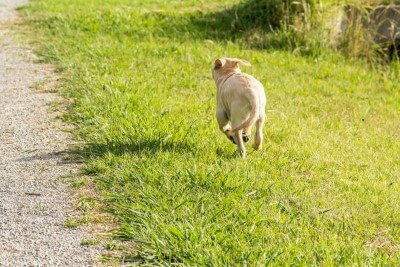HOW TO TEACH YOUR DOG TO COME!
Of course most dogs do ‘come’ – eventually. The problem for most owners is that their dog does not respond quickly or reliably to their ‘come’ command especially when in an interesting environment such as an off lead dog park where so many tempting distractions abound.
SO WHAT HAS GONE WRONG!
While breed and individual personality differences will make this exercise much easier for some than for others, most dogs fail to ‘come’ because their training has been incomplete or stalled in one or more important area such as:
- Inattention and a weak response to name
- Not knowing exactly what ‘come’ means
- Too few rewards for coming and/or
- Too many rewards for not coming.
- Associating coming/being caught with punishment
Come is probably the most important exercise you will ever teach your dog so it is worth taking the time to train thoroughly each of the several components which make up this exercise.
HOW DO YOU ACHIEVE A RELIABLE COME!
Here are a few hints to achieve a reliable come.
1. Your name means ‘attention please’.
Make sure your dog understands that whenever he hears his name he should look at you. If you don’t succeed in getting that initial attention you’ve got no hope of getting ‘come’! Even though you don’t actually want your dog to ‘come’ on his name – you might want to say ‘Rover – stay – your dog should learn that his name means “listen carefully because what follows is important for you”. Always reward your dog for responding to his name with praise treats or a game.
2. What exactly does “Come” mean?
The word ‘Come’ has no more meaning to your dog than a nonsense word like ‘furber’. You must give it meaning by associating it with a position close to you where your hand is on his collar (so you may attach the lead) and he receives praise and treats. In a pleasant manner say “come” just as you would in the park and follow immediately with a treat. Repeat frequently at different times and in different locations.
Never give your dog a treat unless you are holding his collar. This prevents creating a dog who comes close to you, grabs a treat but manages to stay just outside the “gotch-ya” zone. Next, repeat this exercise on lead. While out walking, surprise your dog by suddenly saying his name followed by the word “come” and move quickly away from him. Encourage your dog to into ‘come’ position, by taking his collar and rewarding him.
3. Reward “Come!” often.
You need to establish a long ‘reward history’ for coming to you when called. Reward your dog for every ‘check in’ with you with praise and/or treats and by giving permission to run free again. The more you reward your dog for coming to you the quicker he/she will learn that coming to you is good.
4. Take away rewards for NOT coming.
When your dog continues to play, sniff or run while you call ‘come’ he is being rewarded for ignoring you. The only way to take away these rewards is to keep your dog on a lead or long drag line https://kumalong.com.au/product/single-lead-20mm-width/ until his behaviour becomes more reliable. Hold the end of the line and regularly repeat the walk/come exercise in 2 above by calling your dog to you and rewarding him with praise and treats before allowing him to go play again. If your dog chooses to ignore you however, immediately stop all play, guide him in on the line, show him the treat he could have had then, keeping the lead short, turn your back on him for a brief time before allowing him to try again. Soon your dog will realize that if he comes first time he gets the treat, praise and play quickly continues. If he chooses to ignore you play, praise and treats cease immediately. A long line* ensures that coming is not optional and will make your ‘come game’ the best game in town.
5. NEVER EVER PUNISH your dog for coming to you or for allowing you to catch him.
In either case from your dog’s point of view he is being punished for being caught. Next time he’ll be faster and craftier. If you have to ‘collect’ your dog you may not feel like rewarding him but try to stay as neutral as possible and simply put the lead on and get over it – punishment might make you feel better but it will only set back your dog’s recall training. Similarly if you need to do something your dog perceives as unpleasant such as putting him outside, going to the vets or having a bath – do not call him to you. Simply go to him and put a lead on with as little emotion as possible.
*always supervise your dog carefully when attached to a drag line to avoid tangles with people or other dogs.
Hints for a better ‘Come’.
- Dogs hear better in a higher register so raise your voice higher rather than louder. Sound eager and pleased to see your dog and avoid tones of anger.
- Dogs see and are attracted to movement more than to stationary objects. Moving away from your dog as you call, crouching down low and holding your hands out wide and waving can be more attracting to your dog than standing still.
- Don’t call your dog in the middle of a sniff or game with another dog. If you were engrossed in a conversation or TV programme you probably wouldn’t hear someone calling you either! Wait for a pause, then use your best and loudest calling voice to attract your dog. Remember, you’ll have more success with a cue that sounds inviting rather than threatening.
- Squeaky toys https://kumalong.com.au/product-category/dog-toys/ or whistles will often get your dog’s attention when your voice may not. Although these are not a ‘command’ or ‘cue, if they prompt your dog to come to you that’s great. Just remember these prompts won’t stay effective unless the behaviour they prompt (coming to you) is rewarded.
- If all else fails, try lying down, often a dog will be so surprised to see you on the ground he’ll come running over to check you out.
- If your dog is not likely to come when called don’t even try but rather go and get him when he settles. Calling your dog when you expect to fail will only weaken the command and reinforce your dog’s view that ‘come’ is irrelevant.
Article courtesy of ©Karin Larsen Bridge – other than for personal use, no part of this article may be reproduced without permission of the author.




